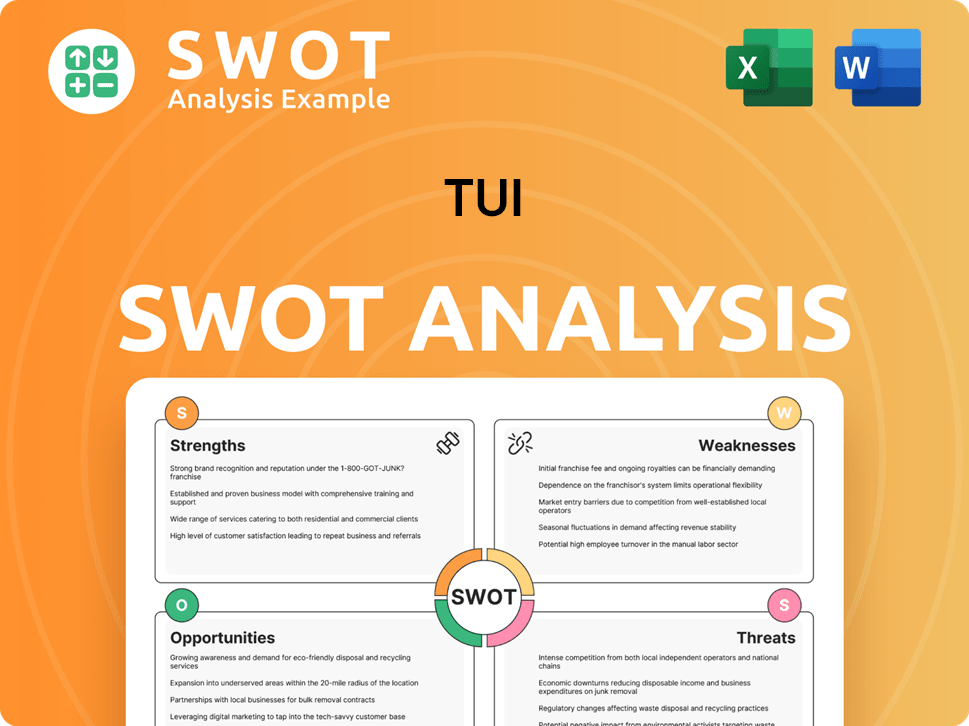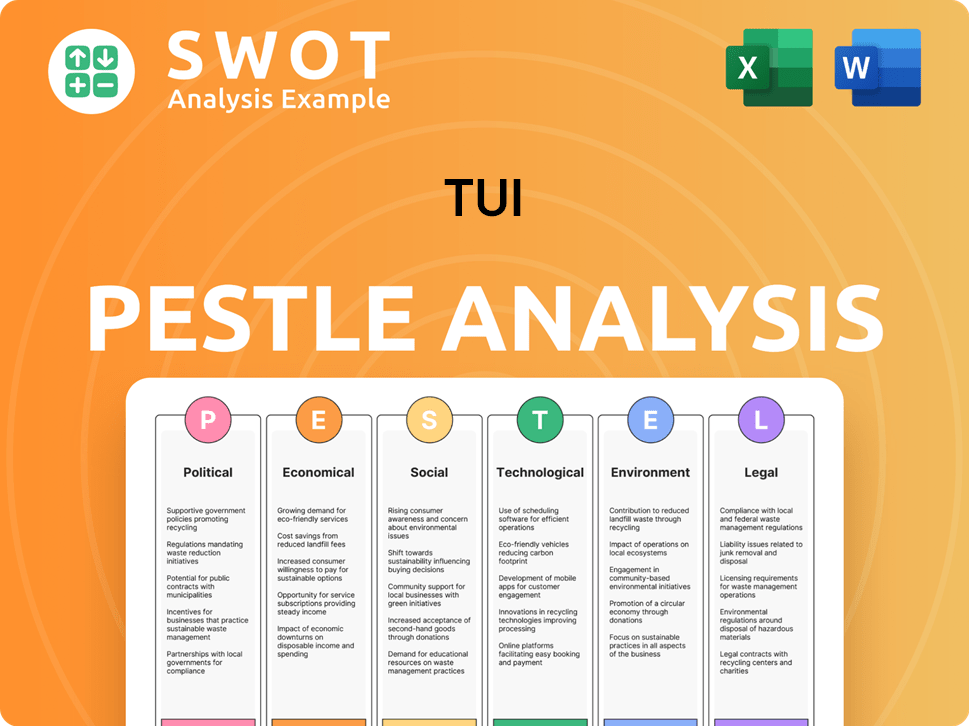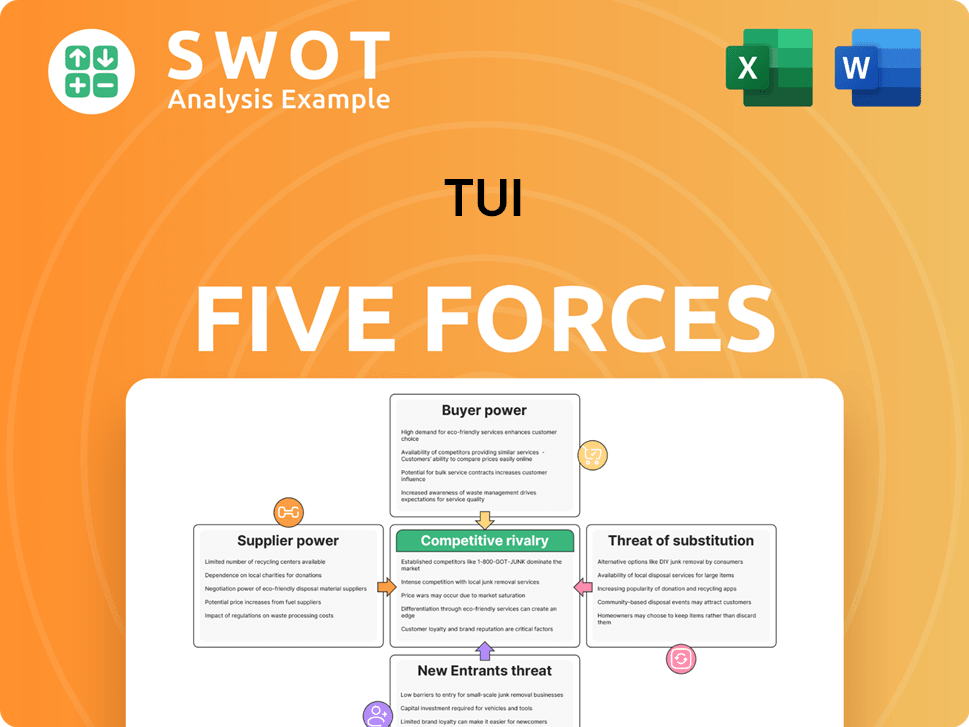TUI Bundle
How Did a Mining Company Become a Global Travel Giant?
Ever wondered how a company could dramatically transform from a Prussian mining operation into the world's largest travel and tourism group? The story of the TUI company is a compelling narrative of strategic pivots and remarkable growth. From its humble beginnings in 1923, TUI's journey offers a fascinating look at how a business can redefine itself within the dynamic tourism industry. Discover the pivotal moments that shaped this German tourism powerhouse.

This article delves into the brief history of TUI, exploring its evolution from Preussag AG to the globally recognized TUI Group. We'll uncover the key milestones, including its shift towards the travel company sector and its expansion through strategic acquisitions. Gain insights into TUI's current operations, its TUI SWOT Analysis, and its impact on the German tourism and broader global tourism industry, examining its financial performance and future outlook.
What is the TUI Founding Story?
The TUI history begins on December 1, 1968, with the merger of four German tour operators: Touropa, Scharnow-Reisen, Hummel-Reisen, and Dr. Tigges-Fahrten. This consolidation in Hanover, Germany, marked the birth of Touristik Union International, or TUI, aiming to create a powerful entity in the growing post-war German travel market.
The founding companies brought different strengths to the table. Dr. Tigges-Fahrten, established in 1928, had a history of innovative study trips. The other companies emerged in the early 1950s, capitalizing on the renewed interest in holidays among Germans. This was a time of economic recovery and increased disposable income, fueling the demand for leisure travel.
The initial business model centered on offering comprehensive package holidays, which provided convenience and predictability. This integrated approach, combining various travel services, was a key differentiator. The merger itself was likely funded through a pooling of existing resources and market presence rather than traditional startup funding. Impressively, TUI reached over one million customers by 1969, just a year after its formation. This rapid growth reflected the favorable economic and cultural conditions of post-war Germany.
TUI SWOT Analysis
- Complete SWOT Breakdown
- Fully Customizable
- Editable in Excel & Word
- Professional Formatting
- Investor-Ready Format

What Drove the Early Growth of TUI?
The early growth and expansion of the TUI company, a prominent travel company, were marked by strategic acquisitions and diversification, which solidified its position in the tourism industry. This period saw significant moves to broaden its reach and service offerings. The company's evolution reflects a dynamic adaptation to the changing landscape of the German tourism sector and beyond.
In 1970, airtours international joined TUI, followed by TransEuropa-Reisen in 1972. These acquisitions expanded TUI's reach and product range, particularly in customized air travel and upscale vacation packages. The company actively expanded its hotel portfolio, launching the Robinson brand and acquiring stakes in hotel chains like Iberotel (1972) and RIU (1977). This vertical integration gave TUI greater control over the holiday experience.
Geographical expansion was a key focus in the 1980s, with TUI developing various European source markets. The company ventured into new markets, founding subsidiaries in the Netherlands, Belgium, Austria, and Switzerland between 1995 and 1996. This strategic move allowed TUI to establish itself as a one-stop shop for vacations across multiple countries.
A significant turning point occurred in 1997 when TUI became part of the industrial conglomerate Preussag AG. By 1999, Preussag had increased its interest in TUI to 100%. In January 2000, TUI Group officially became the tourism division of the restructured Preussag AG. This integration provided substantial capital and strategic backing, further accelerating TUI's growth trajectory. You can learn more about Revenue Streams & Business Model of TUI.
In 2002, Preussag AG itself rebranded as TUI AG, signifying its complete transformation into a tourism-focused company. This rebranding introduced the iconic TUI Smile logo. This marked a pivotal moment in TUI's history, solidifying its identity as a leading player in the global travel market. The company's evolution from its early years to its current status reflects its adaptability and strategic vision.
TUI PESTLE Analysis
- Covers All 6 PESTLE Categories
- No Research Needed – Save Hours of Work
- Built by Experts, Trusted by Consultants
- Instant Download, Ready to Use
- 100% Editable, Fully Customizable

What are the key Milestones in TUI history?
The TUI company has a rich TUI history marked by significant milestones that have shaped its trajectory within the tourism industry. These achievements showcase its evolution from its early beginnings to its current status as a global leader. The TUI group has consistently adapted to market changes, ensuring its continued relevance and growth in the competitive travel market.
| Year | Milestone |
|---|---|
| 2007 | Merger of TUI's tour operator business with First Choice, creating TUI Travel PLC, expanding its global footprint. |
| 2008 | Launch of TUI Cruises under the 'Mein Schiff' brand, establishing a strong presence in the cruise market. |
| 2014 | Reunification with TUI Travel PLC, solidifying TUI as a globally integrated tourism group, actively investing in hotels and cruise ships. |
| 2015 | Establishment of the core hotel brand TUI Blue and expansion of the TUI Cruises and Hapag-Lloyd Cruises fleet. |
| 2018 | Acquisition of the Italian Musement platform, building TUI's third growth pillar in the experiences and activities business. |
TUI's innovations have been pivotal in its growth and adaptation within the travel sector. The company has consistently introduced new services and technologies to enhance customer experiences and operational efficiencies. These innovations have helped TUI maintain its competitive edge in the dynamic travel company landscape.
The launch and expansion of the 'Mein Schiff' brand have significantly contributed to TUI's market presence. This strategic move allowed TUI to capture a larger share of the cruise market.
The creation of the TUI Blue hotel brand has provided a consistent and recognizable brand across various destinations. This has enhanced customer loyalty and brand recognition within the German tourism sector.
TUI has invested in dynamically packaged travel options to cater to changing customer preferences. This allows for more flexible and personalized travel experiences.
The acquisition of Musement has expanded TUI's offerings to include experiences and activities. This diversification strengthens TUI's position in the market.
TUI's commitment to sustainability includes initiatives to reduce environmental impact. This shows a proactive approach to address industry challenges.
TUI continues to integrate technology to improve customer experience and operational efficiency. This includes online booking platforms and personalized travel recommendations.
Despite its successes, TUI has faced significant challenges, particularly the impact of global events. The company has demonstrated resilience by adapting its strategies and operations to navigate these difficulties. For more insights into TUI's strategic approach, consider reading about the Growth Strategy of TUI.
The global pandemic severely affected the travel industry, leading to significant disruptions for TUI. This required substantial adjustments to operations and financial strategies.
Changes in customer preferences and economic conditions pose ongoing challenges. TUI must continuously adapt to remain competitive.
Increasing environmental regulations and consumer demand for sustainable travel options create new challenges. TUI is responding with sustainability initiatives.
Economic downturns and inflation can impact consumer spending on travel. TUI has to manage its financial performance and pricing strategies.
Managing a global travel company with diverse operations presents logistical and operational complexities. This requires efficient coordination and management.
Geopolitical instability and travel restrictions can disrupt travel plans and impact revenues. TUI must monitor and respond to these risks.
TUI Business Model Canvas
- Complete 9-Block Business Model Canvas
- Effortlessly Communicate Your Business Strategy
- Investor-Ready BMC Format
- 100% Editable and Customizable
- Clear and Structured Layout

What is the Timeline of Key Events for TUI?
The TUI company, a prominent player in the tourism industry, has a rich history marked by significant milestones and strategic shifts. From its origins in 1923 as Preussag AG to its current status as a global travel company, TUI's history reflects a journey of expansion, mergers, and a relentless focus on providing comprehensive leisure experiences. The evolution of TUI group showcases its adaptability and commitment to innovation within the dynamic landscape of German tourism and beyond.
| Year | Key Event |
|---|---|
| 1923 | Preussag AG, a German mining and foundry company, was founded. |
| 1968 (December) | Touristik Union International (TUI) was established through the merger of four German tour operators. |
| 1997 | TUI became part of Preussag AG. |
| 2000 (January) | TUI Group became the tourism division of the restructured Preussag AG. |
| 2002 | Preussag AG was rebranded as TUI AG, fully focusing on tourism. |
| 2007 | TUI's tour operator business merged with British First Choice, forming TUI Travel PLC. |
| 2008 | TUI Cruises launched with the 'Mein Schiff' brand. |
| 2014 | Reunification with TUI Travel PLC, establishing TUI as a globally integrated tourism group. |
| 2015 | TUI Blue hotel brand was established, and cruise fleets expanded. |
| 2018 | Musement platform was acquired, expanding into experiences and activities. |
| 2022 | Return to growth and development post-pandemic, with expanded product range. |
| 2023 | An ambitious sustainability agenda was launched. |
| 2024 | Achieved €23.2 billion in revenue and underlying EBIT of €1.3 billion. |
| 2025 (Q1) | Revenue rose by 13% to €4.9 billion, with underlying EBIT soaring to €51 million. |
In 2024, TUI reported a revenue of €23.2 billion, marking a 12% increase year-on-year. Underlying EBIT reached €1.3 billion, a 33% rise. The first quarter of 2025 saw revenue increase by 13% to €4.9 billion, with underlying EBIT reaching €51 million. These figures demonstrate strong financial health and growth.
TUI is focused on expanding its digital platforms and core businesses, including hotels and cruises. The company is exploring new markets in Asia, Latin America, and Southeast Asia to diversify its base. Ongoing initiatives include re-fleeting Marella Cruises and exploring future options for the cruise business.
TUI anticipates a revenue increase of 5% to 10% and underlying EBIT growth of 7% to 10% in fiscal year 2025. This growth will be driven by strong customer demand and the ongoing transformation of its Markets & Airline business. The company is committed to operational excellence, sustainable practices, and personalized holidays.
The expansion into new markets and continued investment in digital platforms are key strategies for TUI’s future. The company is also focused on maximizing customer lifetime value and leveraging synergies across its divisions. For more insights into the ownership structure, see Owners & Shareholders of TUI.
TUI Porter's Five Forces Analysis
- Covers All 5 Competitive Forces in Detail
- Structured for Consultants, Students, and Founders
- 100% Editable in Microsoft Word & Excel
- Instant Digital Download – Use Immediately
- Compatible with Mac & PC – Fully Unlocked

Related Blogs
- What is Competitive Landscape of TUI Company?
- What is Growth Strategy and Future Prospects of TUI Company?
- How Does TUI Company Work?
- What is Sales and Marketing Strategy of TUI Company?
- What is Brief History of TUI Company?
- Who Owns TUI Company?
- What is Customer Demographics and Target Market of TUI Company?
Disclaimer
All information, articles, and product details provided on this website are for general informational and educational purposes only. We do not claim any ownership over, nor do we intend to infringe upon, any trademarks, copyrights, logos, brand names, or other intellectual property mentioned or depicted on this site. Such intellectual property remains the property of its respective owners, and any references here are made solely for identification or informational purposes, without implying any affiliation, endorsement, or partnership.
We make no representations or warranties, express or implied, regarding the accuracy, completeness, or suitability of any content or products presented. Nothing on this website should be construed as legal, tax, investment, financial, medical, or other professional advice. In addition, no part of this site—including articles or product references—constitutes a solicitation, recommendation, endorsement, advertisement, or offer to buy or sell any securities, franchises, or other financial instruments, particularly in jurisdictions where such activity would be unlawful.
All content is of a general nature and may not address the specific circumstances of any individual or entity. It is not a substitute for professional advice or services. Any actions you take based on the information provided here are strictly at your own risk. You accept full responsibility for any decisions or outcomes arising from your use of this website and agree to release us from any liability in connection with your use of, or reliance upon, the content or products found herein.